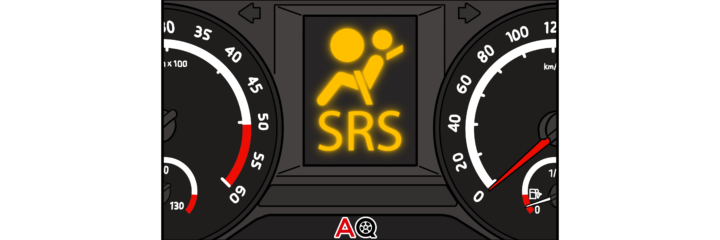Without being too wordy, the Supplement Restraint System (SRS) is simply referring to your vehicle’s airbag system. So, the SRS indicator is a warning light indicating a fault with the airbag system.
The system involves a network of several components that provide additional safety for the driver and passengers in the event of an accident. As you can imagine, it’s not safe to drive with the SRS indicator illuminated on your dashboard, even though you certainly can. The indicator often displays the letters “SRS” or a stick figure of a person strapped in with a seatbelt and facing an airbag.
How Does the Supplement Restraint System Work?
In the event of an accident or collision, the SRS will deploy the airbags to protect the driver and passenger from going through the windshield or slamming violently on the steering wheel and dashboard areas. The system will also trigger the seatbelts to tighten further while the airbags deploy to reduce serious injuries to the upper bodies of the driver and passenger.
The various components that make up the SRS include the airbag module, airbag sensors, clockspring, seat belt tensioner, and the SRS module. Now, let’s take a quick look at these components:
- The airbag module houses the airbag and inflator assembly.
- The airbag sensors measure the conditions and intensity of impacts that could lead to a potential collision. If the sensors detect such conditions, it relays the data to the SRS module which will then deploy the airbags.
- The clockspring is an assembly of flat wire that acts as a connector mechanism to allow the steering wheel to turn without losing electrical signals.
- The SRS module deploys the airbags in the event of a collision or an accident.
Newer car models may have other components, but these itemized above are the basic components that make up your vehicle’s Supplement Restraint System (SRS). Each time you crank up your engine, the SRS light will run a self-test to check if it is working as it should. The light should go off a few seconds after the SRS has confirmed the system is working as it should.
But if the light doesn’t go off after the initial self-test on engine startup, then there is a problem with one or more of the SRS components. The SRS works with sensors. This means your car is fitted with impact sensors in specific impact zones of your vehicle. Each of these sensors, alongside the other components, works with the SRS to ensure the airbags and other safety features connected to the system do their jobs appropriately.
So, if any of these components malfunction, it will affect the SRS and turn on the indicator light till the problem is corrected. For instance, a faulty seat belt latch, corrosion in any of the SRS components, bad clockspring, or a dead SRS computer battery could trigger the SRS indicator. These are some of the potential issues that can trigger the SRS indicator light, and the light will remain on your dashboard until the issues are fixed, and the system reset.
Final Thoughts
The Supplement Restraint System light won’t prevent your car from starting or running. It is only there to warn you of a malfunction in the SRS. While the SRS is dependent on the acceleration, the system is independent of the speed. What this means is that speed is not the sole determinant of whether the system will deploy airbags. So, the airbags can be deployed even when your car is stationary, triggered by an external impact on the vehicle.
While you can very well drive your car with the SRS indicator on, the presence of the indicator is a sign of a malfunction in the SRS. A malfunctioning SRS deactivates the system. and your airbags won’t work or deploy when you need it. Because the health of the SRS is a safety issue, it should never be ignored. A qualified automobile technician can investigate and make repairs so you can get back on the road, safely.


